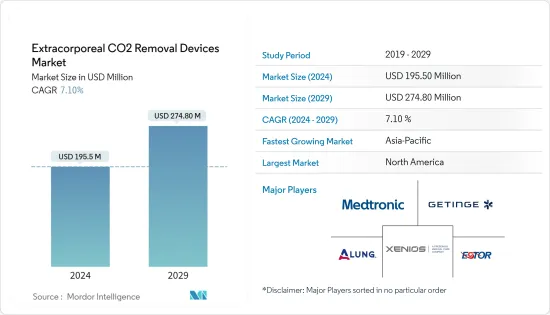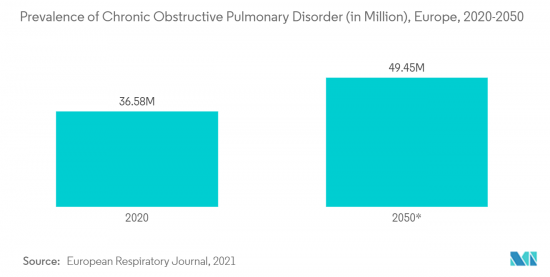
|
市場調査レポート
商品コード
1406994
体外式CO2除去装置-市場シェア分析、産業動向・統計、成長予測、2024年~2029年Extracorporeal CO2 Removal Devices - Market Share Analysis, Industry Trends & Statistics, Growth Forecasts 2024 - 2029 |
||||||
カスタマイズ可能
適宜更新あり
|
|||||||
| 体外式CO2除去装置-市場シェア分析、産業動向・統計、成長予測、2024年~2029年 |
|
出版日: 2024年01月04日
発行: Mordor Intelligence
ページ情報: 英文 110 Pages
納期: 2~3営業日
|
全表示
- 概要
- 目次
体外式CO2除去装置市場規模は、2024年に1億9,550万米ドルと推定され、2029年までには2億7,480万米ドルに達すると予測され、予測期間中(2024年~2029年)にCAGR 7.10%で成長する見込みです。

COVID-19パンデミックは、体外式CO2除去装置市場の成長に影響を与えました。例えば、2021年4月にLancet Respiratory Medicineに掲載された調査研究によると、喘息の人の重症COVID-19のリスクは比較的小さいですが、COPDや間質性肺疾患の人はCOVID-19による重症化リスクが中程度増加するようです。このように、パンデミックは市場の成長に影響を与えました。しかし、規制や貿易障壁が撤廃されたことで、ECMO装置のサプライチェーンが拡大し、予測期間中の市場成長を促進すると予想されます。
COPDやその他の呼吸器疾患の有病率の増加、製品の上市・承認数の増加などの要因が、予測期間中の市場成長を後押しすると予想されます。
慢性閉塞性肺疾患(COPD)やその他の疾患の有病率の増加は、市場成長を促進する主な要因です。例えば、2021年1月にPLOS ONEに発表された研究によると、フランスでは約260万人がCOPDを患っています。2025年には、この数は280万人に増加すると予想されています。さらに、National Health Scienceが発表した2022年の統計によると、英国では2020年から2021年に約117万人がCOPDと診断され、これは全人口の1.9%を占めています。このように、人口におけるCOPDの高い負担は、血流を活性化し、効率的なガス交換を行うための体外式CO2除去装置の需要を高め、それゆえ市場成長を推進しています。
さらに、企業活動が活発化し、製品上市や製品承認が増加することで、市場におけるCO2除去装置の利用可能性が高まり、それが市場成長を促進すると予想されます。例えば、2021年11月、ALung Technologiesは、初の体外式二酸化炭素除去装置であるHemolung呼吸補助システムについてFDAのde novo認可を取得しました。
新たな技術により、新たな患者層や、ECMO技術を病院内・病院間搬送の両方に機動的に利用できるようになるなど、有用な形でECMO技術の潜在的用途の数が増加しています。短期および長期のECMO応用に利用可能な装置については、著しい技術的進歩が観察されています。生体適合性を向上させた最新のECMOシステムは小型化され、持ち運びが可能で、この技術をより簡単で安全な方法で提供することができます。
そのため、COPDやその他の呼吸器疾患の負担が大きいことや、製品承認が増加していることなどの要因により、ECMO市場は予測期間中に成長すると予想されます。しかし、体外式CO2除去治療中の合併症のリスクは、予測期間における体外式CO2除去装置市場の成長を妨げる可能性が高いです。
体外式CO2除去装置市場の動向
慢性閉塞性肺疾患(COPD)セグメントが予測期間中に大きな市場シェアを占める見込み
慢性閉塞性肺疾患セグメントは、人口の慢性閉塞性肺疾患患者の増加などの要因により、予測期間中に市場で大きな成長が見込まれます。
European Respiratory Journalに掲載された論文によると、2021年11月のパンデミックでは、約3,650万人の欧州人がCOPDに罹患しており、この数は2050年までに4,940万人に達すると予測されています。さらに、2021年3月にAnnals of Intensive Careに掲載された論文によると、COPD患者用の最新のECCO2R装置は、非常に低い血流速度で作動し、極小のダブルルーメンカニューレを挿入するだけでよいため、比較的簡単に使用できることが観察されました。
さらに、2022年8月にERS Journalに掲載された論文によると、2050年までに約6億4,560万人(男性4億5,440万人、女性1億9,120万人)がCOPDに罹患すると予測されており、これは世界の有病率が前年に比べて相対的に36%増加することを示しています。このように、深刻な公衆衛生問題であるCOPDの有病率は、特に新興国において上昇することが予想され、余分な二酸化炭素を除去する効果的な装置の需要が増加すると予想されるため、このセグメントの成長を後押ししています。
このように、上記の要因から、調査セグメントは予測期間中にかなりの成長を示すと予想されます。

北米が予測期間中に大きな市場シェアを占める見込み
北米は、COPD、喘息などの呼吸器疾患の発生率の増加、政府のイニシアチブの高まり、整備されたヘルスケアシステムの存在などの要因により、市場全体で大きなシェアを占めると予想されます。
人口の間で呼吸器疾患の負担が増加していることが、同地域の市場成長を促進する主な要因です。例えば、2022年8月にNLMに掲載された論文によると、急性呼吸窮迫症候群(ARDS)は毎年、世界で300万人、米国で20万人の重症患者が罹患していることが確認されています。また、2021年11月にNLMに掲載された論文によると、慢性呼吸器疾患(CLRD)は米国における死因の第4位であり、毎年約1,480万人がCOPDと診断され、2,500万人以上が喘息を発症しています。
さらに、政府や非政府組織による取り組みが増加していることが、全体の収益を増加させています。例えば、CDCのNational Asthma Control Program(NACP)は、喘息患者の教育に資金を提供しています。このようなイニシアチブは、喘息に対する認識を高め、喘息を治療する吸入器の需要および採用を増加させ、それによって市場の成長を促進する可能性が高いです。
その上、同地域におけるヘルスケア支出の増加や様々な呼吸器疾患に対する調査費の増加は、体外式CO2除去装置の採用に拍車をかけると予想されます。このことは、予測期間中に同地域の市場成長を促進すると予想されます。例えば、NIH, Estimates of Funding for Various Research, Condition, and Disease Categories(RCDC)によると、2021年の1億4,400万米ドルに比べ、2022年5月、米国ではCOPD、2022年の研究に約1億5,000万米ドルが費やされました。
さらに、さまざまな臨床試験を実施する企業活動の高まりは、高度な呼吸器装置の開発を増加させ、これも市場成長に寄与しています。例えば、2021年3月、ALung Technologies, Inc.は、慢性閉塞性肺疾患の急性増悪(AE-COPD)治療のための機械的換気の回避または最小化を研究する米国ベースの無作為化比較ピボタル試験(RCT)であるVENT-AVOIDに100人の患者を登録しました。
したがって、呼吸器疾患の負担増と企業活動の活発化は、予測期間にわたって北米地域の市場を牽引すると予想されます。
体外式CO2除去装置産業概要
体外式CO2除去装置市場は、複数の大手企業が存在するため、競争は中程度です。各社は市場での地位を維持するために、提携、パートナーシップ、契約、新製品の発売など様々な主要戦略を採用しています。市場の主要企業には、Medtronic、Getinge AB、Xenios AG、Alung Technologies、ESTOR SpAなどがあります。
その他の特典:
- エクセル形式の市場予測(ME)シート
- 3ヶ月間のアナリストサポート
目次
第1章 イントロダクション
- 調査の前提条件と市場定義
- 調査範囲
第2章 調査手法
第3章 エグゼクティブサマリー
第4章 市場力学
- 市場概要
- 市場促進要因
- 製品上市数と承認数の増加
- COPDおよびその他の疾患の有病率の増加
- 市場抑制要因
- 体外式CO2除去療法中の合併症リスク
- ポーターのファイブフォース分析
- 新規参入業者の脅威
- 買い手/消費者の交渉力
- 供給企業の交渉力
- 代替品の脅威
- 競争企業間の敵対関係の強さ
第5章 市場セグメンテーション
- 製品別
- 体外式CO2装置
- ディスポーザブル
- その他
- 用途別
- 慢性閉塞性肺疾患(COPD)
- 急性呼吸窮迫症候群(ARDS)
- 肺移植への橋渡し
- その他
- エンドユーザー別
- 病院および診療所
- 外来手術センター
- その他
- 地域別
- 北米
- 米国
- カナダ
- メキシコ
- 欧州
- ドイツ
- 英国
- フランス
- イタリア
- スペイン
- その他欧州
- アジア太平洋
- 中国
- 日本
- インド
- オーストラリア
- 韓国
- その他アジア太平洋地域
- 中東・アフリカ
- GCC
- 南アフリカ
- その他中東・アフリカ
- 南米
- ブラジル
- アルゼンチン
- その他南米
- 北米
第6章 競合情勢
- 企業プロファイル
- Alung Technologies
- ESTOR S.P.A
- Getinge AB
- Medica Spa
- Medtronic
- X-COR Therapeutics
- Xenios AG
第7章 市場機会と今後の動向

The Extracorporeal CO2 Removal Devices Market size is estimated at USD 195.5 million in 2024, and is expected to reach USD 274.80 million by 2029, growing at a CAGR of 7.10% during the forecast period (2024-2029).
The COVID-19 pandemic impacted the growth of the extracorporeal CO2 removal devices market. For instance, as per the research study published in the Lancet Respiratory Medicine in April 2021, the risk of severe COVID-19 in people with asthma is relatively small, but people with COPD and interstitial lung disease appear to have a modestly increased risk of severe disease due to COVID-19. Thus, the pandemic impacted market growth. However, with removed restrictions and trade barriers, the supply chain of ECMO machines has increased, which is expected to fuel the market growth over the forecast period.
Factors such as the increasing prevalence of COPD and other respiratory diseases, as well as the rising number of product launches and approvals, are expected to boost the market growth over the forecast period.
The increasing prevalence of chronic obstructive pulmonary diseases (COPD) and other diseases is the key factor driving the market growth. For instance, according to the study published in the PLOS ONE journal in January 2021, in France, about 2.6 million people were suffering from COPD. By 2025, that number is expected to rise to 2.8 million. Additionally, according to 2022 statistics published by National Health Science, about 1.17 million people in England were diagnosed with COPD in 2020-21, accounting for 1.9% of the total population. Thus, the high burden of COPD among the population raises the demand for extracorporeal CO2 removal devices for vitalizing blood flow and efficient gas exchange, hence propelling the market growth.
Furthermore, the growing company activities and the growing number of product launches, as well as product approvals, increase the availability of CO2 removal devices in the market, which in turn is anticipated to fuel the market growth. For instance, in November 2021, ALung Technologies received the FDA's de novo clearance for its Hemolung respiratory assist system, the first extracorporeal carbon dioxide removal device.
New technologies are enhancing the number of potential applications for the ECMO technology in useful ways, including new-patient population and the ability to make the ECMO technology mobile for both intra- and inter-hospital transport. For the equipment available for short- and long-term ECMO applications, significant technical advancements have been observed. Modern ECMO systems that have enhanced biocompatibility are miniaturized and portable, and they render the provision of this technique in a simpler and safer way.
Therefore, owing to factors such as the high burden of COPD and other respiratory disorders as well as growing product approvals, the studied market is anticipated to grow over the forecast period. However, the risks of complications during extracorporeal CO2 removal therapy are likely to hinder the growth of the extracorporeal CO2 removal devices market over the forecast period.
Extracorporeal CO2 Removal Devices Market Trends
Chronic Obstructive Pulmonary Disease (COPD) Segment is Expected to Hold a Significant Market Share Over the Forecast Period
The chronic obstructive pulmonary diseases segment is anticipated to witness significant growth in the market over the forecast period owing to factors such as the increasing cases of chronic obstructive pulmonary diseases among the population.
According to an article published in the European Respiratory Journal, in November 2021, about 36.5 million Europeans were suffering from COPD during the pandemic, and this number is projected to reach 49.4 million by 2050. Additionally, according to an article published in the Annals of Intensive Care in March 2021, it was observed that the newest ECCO2R devices for COPD patients were relatively easy to use as they work with very low blood flow rates and just require the insertion of a tiny double-lumen cannula.
Additionally, according to an article published in ERS Journal in August 2022, it was projected that about 645.6 million people (454.4 million men and 191.2 million women) were expected to have COPD by 2050, representing a 36% relative increase in global prevalence as compared to the previous year. Thus, the prevalence of COPD, a serious public health issue, is expected to rise, especially in emerging countries, which is anticipated to increase the demand for effective devices to remove extra carbon dioxide, hence propelling the segment's growth.
Thus, owing to the abovementioned factors, the studied segment is expected to show considerable growth over the forecast period.

North America is Expected to Have the Significant Market Share Over the Forecast Period
North America is expected to hold a significant market share in the overall market owing to the factors such as the increasing incidences of respiratory disorders such as COPD, asthma, and others, the growing government initiatives, and the presence of a well-developed healthcare system.
The growing burden of respiratory disorders among the population is the key factor driving the market growth in the region. For instance, according to an article published in NLM, in August 2022, it has been observed that acute respiratory distress syndrome (ARDS) affects 3 million patients worldwide and 200,000 people in the United States in critical illness settings, every year. Also, an article published in NLM, in November 2021 stated that chronic lower respiratory disease (CLRD) is the fourth leading cause of death in the United States, approximately 14.8 million people are diagnosed with COPD and more than 25 million people have had asthma every year.
Additionally, the rise in the number of initiatives undertaken by government and non-government organizations is increasing the overall revenue. For instance, CDC's National Asthma Control Program (NACP) provides funds for educating asthma-affected patients. Such initiatives are likely to increase awareness about asthma, which will increase the demand as well as the adoption of inhalers treating asthma, thereby propelling the market growth.
Furthermore, the growing healthcare expenditure and the rising research spending on various respiratory diseases in the region are anticipated to fuel the adoption of extracorporeal CO2 removal devices. This is expected to boost the market growth in the region over the forecast period. For instance, according to the NIH, Estimates of Funding for Various Research, Condition, and Disease Categories (RCDC), in May 2022, about USD 150 million was spent on research for COPD, 2022 in the United States as compared to USD 144 million in 2021.
Moreover, the rising company activities in conducting various clinical trials increase the development of advanced respiratory devices which is also contributing to the market growth. For instance, in March 2021, ALung Technologies, Inc. enrolled 100 patients in the United States-based VENT-AVOID, a randomized, controlled pivotal trial (RCT) studying the avoidance or minimization of mechanical ventilation for the treatment of acute exacerbations of chronic obstructive pulmonary disease (AE-COPD).
Therefore, the rising burden of respiratory diseases and increasing company activities are expected to drive the market in the North American region over the forecast period.
Extracorporeal CO2 Removal Devices Industry Overview
The extracorporeal Co2 removal devices market is moderately competitive due to the presence of several major players. The companies are adopting various key strategies such as collaborations, partnerships, agreements, and new product launches to retain their position in the market. Some of the key companies in the market include Medtronic, Getinge AB, Xenios AG, Alung Technologies, and ESTOR SpA.
Additional Benefits:
- The market estimate (ME) sheet in Excel format
- 3 months of analyst support
TABLE OF CONTENTS
1 INTRODUCTION
- 1.1 Study Assumptions and Market Definition
- 1.2 Scope of the Study
2 RESEARCH METHODOLOGY
3 EXECUTIVE SUMMARY
4 MARKET DYNAMICS
- 4.1 Market Overview
- 4.2 Market Drivers
- 4.2.1 Rising Numbers of Product Launches and Approvals
- 4.2.2 Increasing Prevalence of COPD and Other Diseases
- 4.3 Market Restraints
- 4.3.1 Risks of Complications During Extracorporeal CO2 Removal Therapy
- 4.4 Porter's Five Forces Analysis
- 4.4.1 Threat of New Entrants
- 4.4.2 Bargaining Power of Buyers/Consumers
- 4.4.3 Bargaining Power of Suppliers
- 4.4.4 Threat of Substitute Products
- 4.4.5 Intensity of Competitive Rivalry
5 MARKET SEGMENTATION (Market Size by Value - USD million)
- 5.1 By Product
- 5.1.1 Extracorporeal CO2 Devices
- 5.1.2 Disposables
- 5.1.3 Others
- 5.2 By Application
- 5.2.1 Chronic Obstructive Pulmonary Disease (COPD)
- 5.2.2 Acute Respiratory Distress Syndrome (ARDS)
- 5.2.3 Bridge to Lung Transplant
- 5.2.4 Others
- 5.3 By End User
- 5.3.1 Hospitals and Clinics
- 5.3.2 Ambulatory Surgical Centers
- 5.3.3 Others
- 5.4 Geography
- 5.4.1 North America
- 5.4.1.1 United States
- 5.4.1.2 Canada
- 5.4.1.3 Mexico
- 5.4.2 Europe
- 5.4.2.1 Germany
- 5.4.2.2 United Kingdom
- 5.4.2.3 France
- 5.4.2.4 Italy
- 5.4.2.5 Spain
- 5.4.2.6 Rest of Europe
- 5.4.3 Asia-Pacific
- 5.4.3.1 China
- 5.4.3.2 Japan
- 5.4.3.3 India
- 5.4.3.4 Australia
- 5.4.3.5 South Korea
- 5.4.3.6 Rest of Asia-Pacific
- 5.4.4 Middle East and Africa
- 5.4.4.1 GCC
- 5.4.4.2 South Africa
- 5.4.4.3 Rest of Middle East and Africa
- 5.4.5 South America
- 5.4.5.1 Brazil
- 5.4.5.2 Argentina
- 5.4.5.3 Rest of South America
- 5.4.1 North America
6 COMPETITIVE LANDSCAPE
- 6.1 Company Profiles
- 6.1.1 Alung Technologies
- 6.1.2 ESTOR S.P.A
- 6.1.3 Getinge AB
- 6.1.4 Medica Spa
- 6.1.5 Medtronic
- 6.1.6 X-COR Therapeutics
- 6.1.7 Xenios AG


